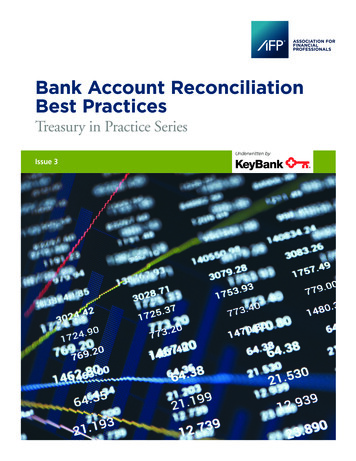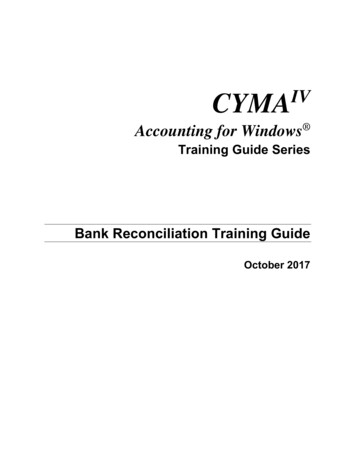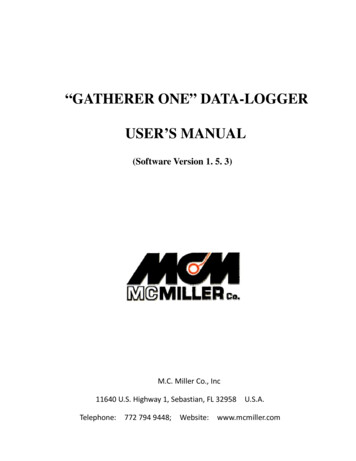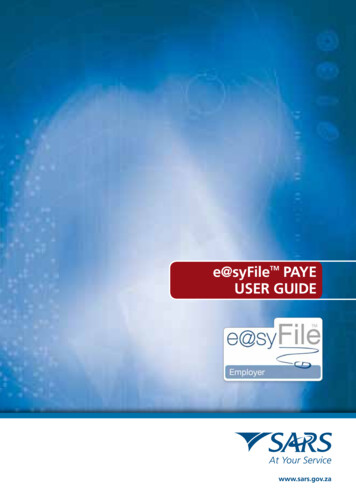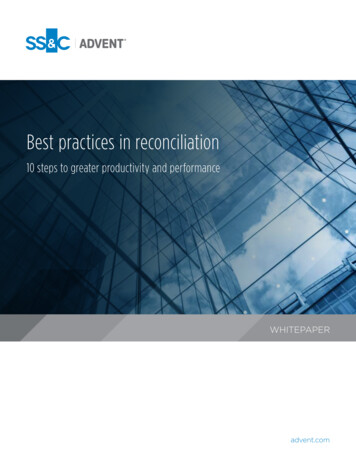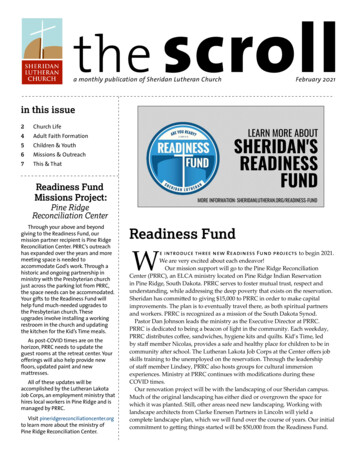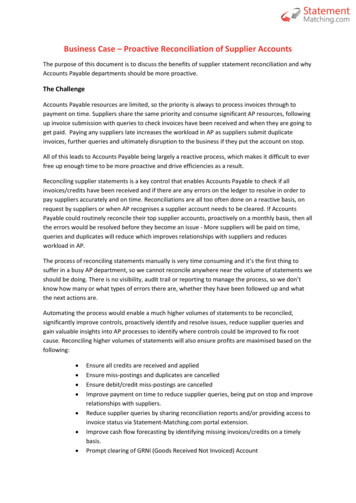
Transcription
Business Case – Proactive Reconciliation of Supplier AccountsThe purpose of this document is to discuss the benefits of supplier statement reconciliation and whyAccounts Payable departments should be more proactive.The ChallengeAccounts Payable resources are limited, so the priority is always to process invoices through topayment on time. Suppliers share the same priority and consume significant AP resources, followingup invoice submission with queries to check invoices have been received and when they are going toget paid. Paying any suppliers late increases the workload in AP as suppliers submit duplicateinvoices, further queries and ultimately disruption to the business if they put the account on stop.All of this leads to Accounts Payable being largely a reactive process, which makes it difficult to everfree up enough time to be more proactive and drive efficiencies as a result.Reconciling supplier statements is a key control that enables Accounts Payable to check if allinvoices/credits have been received and if there are any errors on the ledger to resolve in order topay suppliers accurately and on time. Reconciliations are all too often done on a reactive basis, onrequest by suppliers or when AP recognises a supplier account needs to be cleared. If AccountsPayable could routinely reconcile their top supplier accounts, proactively on a monthly basis, then allthe errors would be resolved before they become an issue - More suppliers will be paid on time,queries and duplicates will reduce which improves relationships with suppliers and reducesworkload in AP.The process of reconciling statements manually is very time consuming and it’s the first thing tosuffer in a busy AP department, so we cannot reconcile anywhere near the volume of statements weshould be doing. There is no visibility, audit trail or reporting to manage the process, so we don’tknow how many or what types of errors there are, whether they have been followed up and whatthe next actions are.Automating the process would enable a much higher volumes of statements to be reconciled,significantly improve controls, proactively identify and resolve issues, reduce supplier queries andgain valuable insights into AP processes to identify where controls could be improved to fix rootcause. Reconciling higher volumes of statements will also ensure profits are maximised based on thefollowing: Ensure all credits are received and appliedEnsure miss-postings and duplicates are cancelledEnsure debit/credit miss-postings are cancelledImprove payment on time to reduce supplier queries, being put on stop and improverelationships with suppliers.Reduce supplier queries by sharing reconciliation reports and/or providing access toinvoice status via Statement-Matching.com portal extension.Improve cash flow forecasting by identifying missing invoices/credits on a timelybasis.Prompt clearing of GRNI (Goods Received Not Invoiced) Account
Using a system to perform automation provides a structured process that you canreport on to quantify errors received by supplier and focus on resolving the rootcause in order to reduce errors over time.Maximise early payment discountsMinimise late payment feesMinimise interruption to the business resulting from supplier’s putting you on stopReduce 3rd party audit recovery feesKey Business BenefitsReconciling supplier statements is the ultimate control to close the loop in Accounts Payable toensure supplier balances are accurate. However, any seasoned AP Manager will know thatreconciling statements delivers far more benefits than the headline suggests, the majority of whichadd value to the wider business in addition to improving AP KPI’s.The table below details the business benefits as a result of AP reconciling supplier statements.Reconciling supplier statements proactively is the key as this will identify issues early, improving thechance of resolving it in time, which benefits the business, Accounts Payable and suppliers.Quantifying the issues and identifying the root cause drives continuous improvement to reduceerrors, which benefits all parties again.Accurate supplier liabilities Paying suppliers on time Accurate financial reportingKey control for audit and SOX complianceReliable cash flow forecasting and accrualsTarget, reduce and stay on top of top suppliers agedGRNI/GRIR balances, improving the P&L.Ensure credits agreed between the supplier and thebusiness have actually been received and applied.Obtaining and processing missing invoices/credits in thecorrect period avoids nasty surprises.Another chance to spot duplicates before they are paid.Avoid business interruption from being on stop or losingsupplier altogetherMaximise any early payment discountsImprove trust in supplier relationship and therefore morelikely to give you favourable terms and treatment whenyou need something from them.Supports contract negotiationsFewer queries from supplier directly to business contactand fewer queries (often a repeat) from the internal APquery team.Identifying issues that might cause late payment earlyenough to reduce the running around an emergencypayment causes.Reduce duplicates that may slip through and be chargedto budget holder.If the issue holding up the payment is down to somethingthe business hasn’t done, which more often than not it is,
then reporting from statement reconciliation process isanother opportunity for management to be made awareof the root causes to reduce all of the above in the future.Objectives for Accounts PayableAutomating the process will enable Accounts Payable to reconcile Key Supplier lists proactively everymonth and higher volumes of statements on an adhoc basis. Coverage objective is to reconcile KeySuppliers that represent 80% of the AP ledger value.Errors will be identified, actioned and followed up to ensure resolution is complete. Reconciliationreports will be shared with suppliers to request missing documents, provide invoice status, includingdue dates for payments and payment references, which will reduce supplier queries.Users adding notes to the recs provides an audit trail and supports analysis to identify where internalcontrols need improvement or vendor issues.Reporting will quantify the errors by supplier to target improvements through root cause analysis.Quantifying the errors when the statement is first uploaded can be compared to the results at theend of the month to measure the value of reconciling statements. KPI’s can be used to monitorperformance and ensure errors reduce over time.The table below details the deliverables required from a solution and the benefits.DeliverablesAutomated reconciliationprocess for Excel, Paper & PDFstatements. Reconciliationsautomatically updated on adaily basis.Exception Management Reconciliation resultshighlighting what’smatched and in error Reports to share resultswith suppliers showinginvoice status Add notes and followup actions Select statementsbased on user criteriaand priorityReporting List statements by errorreason forprioritisation. Critical supplier reports BenefitsHigher volumes of statements can be reconciledcompared to manual processUsers only have the exceptions to manageRequest missing documents on a timely basis and followup to ensure resolved.Resolve incorrect postings on a timely basis and follow upto ensure resolvedo Wrong vendor accounto Duplicateso Debits/credits wrong way roundo Invoice date, invoice number and currency entryerrorsAudit trails provide visibility of previous actions whenfollowing up.Provides structure for team to manage process andmanagement to ensure process is completed.Reduce supplier queries by sharing reconciliation reportsProvides focus for team to resolve errors with mostfinancial impact.Ensure critical suppliers are reconciledTarget areas for improvement based on error volumesMonitor performance over time to see errors reducing
to ensure all arereconciled each period.Number and value oferrors by supplier andoverallAudit reports withsupplier balance vsledger balanceMeasure value achieved by reconciling statementsReconciling supplier statements proactively will identify the following issues and resolving them willensure AP ledgers are accurate, profits are maximised and supplier queries are reduced. Missing Credits – Request copies from suppliers and set follow up actions to ensure thecredit is received. Credit notes can get suppressed from statements or cancelled by suppliersif you don’t take them on a timely basis. Improve the bottom line and ensure the businessgets what it’s owed.Missing Invoices - Request copies from suppliers and set follow up actions to ensure theinvoice is received. Resolves an issue where the supplier may end up putting you on stopand/or sends you duplicates, which creates even more work. Improve payment on time,maximise early payment discount opportunities and maintain accurate supplier balances.GRNI Clearing – If statements are ‘Fully Matched’ (all invoices received and no un-paidinvoices on vendors account dated before the statement date); any Goods Receipts NotInvoiced with a posting date prior to the statement can be cleared based on our rules.Miss-postings – Un-paid invoices on the vendors account that are not on the vendorsstatement need to be investigated and either cancelled or re-posted to the correct vendoraccount. These are potential duplicate risks and impact the bottom line if they are paid.Data Errors – Invoices on the system where the invoice number, invoice amount, invoicedate or currency are different to what the supplier has on their statement. These arepotential duplicate risks, over-payments or under-payments waiting to happen.Components of a Business CaseBuilding a business case to automate supplier statement reconciliation is more about improvingcontrols and best practice rather than hard, tangible savings. However, it’s always difficult forAccounts Payable departments to get funding for their projects, so you have to justify anyinvestment and there should be no arguments from management about the benefits of reconcilinghigher volumes of supplier accounts and there are tangible savings to target as part of an investmentcase. The table below provides some input for discussion.Business Case ComponentReduce Supplier QueriesFTE Saving – ManualReconciliation TargetHow many supplier queries do you receive now?What percentage are invoice status related?How many FTE’s and cost?Target 20% reduction on supplier queries Estimate how long it takes on average to reconcile a keysupplier account manually including follow up.
GRNI/GRIR ClearingReduce duplicatesMissing CreditsAudit Recovery CostExtrapolate to determine time and cost to reconcile thevolume of statements you would to achieve on a monthlybasisTarget 10x volume of statements per person if process isautomated What is the current value of your Top 50 GRNI/GRIRbalances?Target 30% reduction of the value returned to profit Estimate percentage of duplicates received How much is the processing/rejection cost? Estimate 0.5% of annual spend is duplicates that eitherget recovered or go un-noticed.Target 20% reduction in duplicates What is the value of credits processed per year? Estimate 15% of credits may have been missed – What isvalue?Target 5% credits missed instead of 15% If you use a 3rd party audit recovery company then whatwas the cost last year?Target 50% reduction for the next audit recoveryWhat is the proposed solution to automate the reconciliation of supplier statements?Statement-Matching.com is a cloud based solution for automating statement reconciliation andmanaging the exceptions. A proof of concept enables potential customers to try the solution withtheir data to prove it meets the business requirements and also to provide input for the businesscase. Why use Statement-Matching.com? A summary of the key benefits to consider: Easy to setup – No software or hardware to install or maintain, users access the solution viatheir browser. The proof of concept environment is a live system, so it’s already configuredand the AP users are trained. To go live with all of our data, we need a data extract report tobe configured and setup to run automatically overnight. A secure FTP process is required topush daily extract files to keep in synch. Statement-Matching.com is hosted on Microsoft’sAzure platform in the data centre location of choice. There is no connection betweenStatement-Matching.com and our systems as we are pushing the daily files to an FTPaccount and no write backs to our ERP.Automated Reconciliation – Excel statements are uploaded by the AP users, paper and PDFstatements are forwarded to a managed service for data extraction and loading toStatement-Matching.com within 24 hours. Statements are reconciled automatically and anoverall status is allocated as well as a status for each line on the statement. Statements areautomatically re-reconciled every time the daily file is uploaded, so the reconciliations are
always up to date. Statements are by default reconciled against all documents or an as-atdate can be entered to reconcile the statement to a specific date.Managing Exceptions – Reports can be run to list the Top-x suppliers by invoice value toensure they are reconciled every period. Suppliers can also be flagged as critical suppliers onthe system and again reports can be run to ensure critical suppliers are reconciled everyperiod. Users can list statements based on the error eg. Statements with Missing Credits,Missing Invoices, Debits/Credit miss-matches, Documents on system that are not onstatement and so on. Users can also select statements based on legal entity and vendor split.Users can send status reports to suppliers to request copies of missing documents and to letthe supplier know the status of each invoice, due dates for payment and paymentreferences for invoices that we’ve paid, which will reduce the volume of supplier queriesreceived. The daily files from our ERP will contain new documents from the previous day andchanged documents, so any missing documents we subsequently receive and any updateddocuments will be uploaded to Statement-Matching.com and the reconciliations will beupdated automatically as a result.Management Reporting – Reporting tells us how many statements received, completed andvalues reconciled. We can also see the number of and values of each error type eg. missingcredits, missing invoices etc. to monitor progress of reducing errors. KPI reports to measurethe errors identified on initial upload of statements and subsequently measure the value oferrors resolved after the statement has been worked on (missing documents requested andreceived and internal errors such as miss-postings, incorrect amounts and currency errorsfixed). Use reporting to identify the same errors occurring on the same suppliers everymonth in order to resolve root cause and reduce errors over time.Proof of Concept (POC)Complete a Proof of Concept for up to 10 suppliers using production ERP data and supplierstatements. Anyone in Accounts Payable can provide the data required and detailed instructions areavailable on request from Statement-Matching.comWrite up the results of the POC for the business case based on the following: Time saving compared to manual reconciliation process.Quantify number and value of missing invoices, credits, miss-postings, incorrect amounts,currency errors and invoice date/invoice number entry errors.To-be process worked on with customer to agree supplier coverage for reconciliations, workingpractices for AP team and KPI reporting to measure benefits and achieving business case objectives.Build in Statement-Matching.com Portal extension and Duplicate-Matching.com into the businesscase for potential future development and overall justification.
Technical setup and implementation.Beyond the Proof of Concept stage, an automated daily file transfer will need to be setup to synchthe Accounts Payable ledgers with Statement-Matching.com. This needs to be setup on thecustomer side and it’s a one way push of data to an FTP account with no requirements to write anydata back, so there is no direct connection between Statement-Matching.com and customernetworks.There are no setup or training costs on the Statement-Matching.com side as this is done remotely,so the only setup cost is any internal costs on the customer IT side.Statement-Matching.com works with any ERP application and customers can be setup with multipleERP systems and any add-on systems customers use for invoice processing where documents areentered before posting on the ERP system(s).The requirements are the same regardless of system and this is how it works for any ERP system:Statement-Matching.com requires daily invoice header and supplier data files from the customersERP system. The daily files will be output overnight as a scheduled task and automaticallytransferred to an FTP (SFTP/FTPS) account provided by Statement-Matching.com. This will be anautomated process that requires no input from the business and Statement-Mathing.com supportteam will notify the customer if there are any problems with the files or no files are received on agiven day. Statement-Matching.com provides a technical specification for the data extractrequirements, which the customers IT team needs to review in order to estimate the internal costand time to develop the extracts and setup the FTP process. Once the data extract report is ready torun in production, Statement-Matching.com will be up and running within 7-10 days, soimplementation time is minimal on their side.The AP team or at least the AP Super Users will have already been trained and have extensiveknowledge of Statement-Matching as a result of the 4 week POC. However, time will have passedgetting approval after the POC, implementing the full data extracts and working on the to-be processdesign, so the implementation approach is to start from scratch. Training will be provided via webex(1-1.5hrs) once the production data is loaded and weekly calls provided to work through issues,receive additional training and change configuration settings. Weekly calls will revert to monthlycalls once the application is ready for Business As UsualWhat’s included and how does pricing work?Statement-Matching.com is a cloud based application and there are no setup costs. The only costs touse the solution are:Fixed Monthly Subscription – Based on annual invoice volumes.Variable Monthly Statement Charge – Based on the number of statements processed per month.
Invoicing is monthly with each invoice having a line item for the fixed monthly subscription inadvance and monthly statement charge in arrears.There is no limit to the number of users. All of the updates are included in the monthly subscriptionas well as helpdesk support.Monthly Service Reviews are also provided to help us get the most out of the system.Future Development OpportunitiesThe data-set used by Statement-Matching.com for supplier statement reconciliation can also beleveraged to further improve the Accounts Payable processes. There are two additional solutionsthat use the same data-set as Statement-Matching, see below. The solutions are available on thesame monthly subscription basis and no additional setup is required on the customer side. The userinterface is similar to Statement-Matching.com, so training is minimal for the Accounts Payable teamto use them. Both solutions are available on a proof of concept basis.Supplier Portal – Suppliers can see the status of all their invoices (VIM and SAP) and submitmessages, integrated with existing email addresses used for supplier queries. Suppliers can also viewpayments and see the invoices that relate to their payments. Suppliers can also upload their ownstatements and we can see the results in Statement-Matching.com. Supplier Portal is free of chargeto suppliers and the monthly subscription for us is 75% of the fixed monthly subscription cost oncore Statement-MatchingDuplicate-Matching – Configurable duplicate identification reports and workflow to managerecovery/prevention process. Reports can be run on all data (open, paid and no date range) or runagainst data for period of time eg. Yesterday only to identify potential duplicates at the earliestopportunity to prevent them being paid.Statement-Matching are also about to release a new module for Sales Ledger Reconciliation toenable Accounts Receivable to reconcile the sales ledger against statements obtained from oruploaded by customers. This is in effect the reverse of what we’re doing with Statement-Matching inAP whereby we obtain statements from our suppliers to reconcile against the purchase ledger, sothere are real benefits on both sides.
Business Case - Proactive Reconciliation of Supplier Accounts The purpose of this document is to discuss the benefits of supplier statement reconciliation and why Accounts Payable departments should be more proactive. The Challenge Accounts Payable resources are limited, so the priority is always to process invoices through to payment on time.



